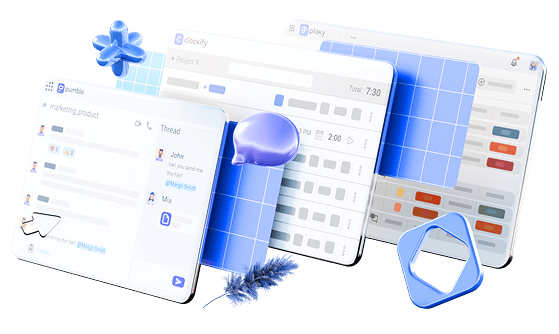As a product-first company, CAKE.com puts a lot of effort into making sure that our 3 products — Clockify, Pumble, and Plaky — bring value to our customers.
But sometimes, offering excellent software isn’t enough to make a company successful.
Instead, we rely on our marketing team to make sure our products are seen by all the right people.
And, as it happens, product marketers play a vital role in that process.
With that in mind, we asked Aleksandra Sarovic, Dijana Stefanovic, and Mirjana Trifkovic — the product marketing managers at Plaky, Pumble, and Clockify, respectively — to share their thoughts on:
- Product marketing in general,
- Their experience in the field, and
- What they see as the future of the industry.
But, before we dive into their answers, allow us to introduce our interviewees.
Meet CAKE.com’s product marketing managers
Aleksandra Sarovic is a product marketing manager with over a decade’s worth of experience in the industry. Having spent 15 years in the roles of a marketing service provider, a client, and even a brand owner, Sarovic developed a comprehensive understanding of traditional marketing. Her work for CAKE.com has allowed her to step into the world of product marketing and develop a strategy for the company’s most recently launched product — the project management and task tracking software, Plaky.
Dijana Stefanovic is a product marketing manager whose interest in marketing was already evident even during her college days. After finishing her studies in engineering management with a focus on marketing, she got hands-on experience by handling the marketing aspect of a variety of projects. That time enabled her to try her hand at different marketing strategies and perfect her craft. However, her work at CAKE.com has allowed her to focus her attention on a single product — the business messaging app, Pumble.
Mirjana Trifkovic is a product marketing manager for CAKE.com’s inaugural software product — the time-tracking app, Clockify. After studying engineering management in college, Trifkovic worked as a project manager with a focus on communicating project results. However, her creative nature led her to eventually return to marketing and take up the mantle of a product marketing manager at CAKE.com. In her opinion, product marketing is the perfect mix of design, storytelling, and communication — three subjects she’s very passionate about.
Product marketing in the SaaS industry: an overview
To begin with, we asked our product marketing managers some general questions about:
- Product marketing,
- Its significance in the SaaS industry, and
- The challenges that may affect their operations.
Read their answers below.
Let’s start with an easy question. What differentiates product marketing from traditional marketing?
Aleksandra: Traditional marketing is all about creating a memorable brand image, like those flashy Super Bowl ads. It focuses on making your brand look cool and trustworthy. On the other hand, product marketing is about showing off your product’s features and specifications.
In reality, these 2 strategies often work together — they’re 2 sides of the same coin. A flashy ad can make people turn to online sources for more details. That’s where product marketing comes in, with detailed info and reviews.
Dijana: I recently came across an article written by a fellow product marketer who sees product marketing as a spin-off of traditional marketing with a focus on digital SaaS products. While traditional marketing shows the benefits that the users/consumers get from the company, product marketing focuses on the features and functions of the product. It emphasizes the benefits users get from the product and the trust other users have already placed in it.
I’d add that product marketing is the art and science of connecting a product with its target audience. We do that by shining a light on the right value propositions in hopes of contributing to the growth and further development of said product. It’s a very dynamic and multifaceted discipline that requires a variety of skills, from market research to storytelling.
Mirjana: In my opinion, traditional marketing tends to deliver a more generic and comprehensive message when promoting a service or a product. Meanwhile, product marketing tends to focus on specific use cases to target specific segments of the audience.
For example, some people use Clockify exclusively for its time-tracking features while others use it for invoicing. Product marketing allows us to target those potential customers separately, and show the product in different situations.
It sounds like product marketing is especially important in the SaaS industry. Why do you think that is?
Aleksandra: The SaaS industry is ever-expanding, especially in light of the global pandemic, which has increased the demand for software solutions. But that doesn’t mean that customers are particularly loyal to the first product they try. In fact, they tend to easily switch between different services.
With that in mind, the role of product marketing is to create a message that resonates with your target audience and gets them to invest in your product, even in a sea of other options. Additionally, product marketing should also focus on keeping existing customers happy.
Dijana: When you’re dealing with the SaaS industry, every product is complex. As a product marketer, you have to have a deep understanding of that technology to be able to communicate its value to your user base in a relatable way.
That is especially important when you have a big feature release — like the one we had this year. When we were preparing to release our video conferencing feature, product marketers had to be there, pulling all the strings to make sure that everything was communicated effectively to our customers. We had to issue announcements, communicate when the feature would go live, and explain its value once it was released. The goal of all this is to make users aware of updates and informed about what they entail.
Mirjana: When deciding on which software product to incorporate into their workflow, most people think rationally. That is to say, they don’t make that decision with their heart; they don’t go for the shiniest product. Instead, they go for the product that will make their daily tasks easier, rather than more difficult — and that’s something that is communicated through product marketing.
Creating a successful product marketing strategy must be pretty difficult. What are some of the biggest challenges you face in that regard?
Aleksandra: I suppose one of the most enduring challenges I’ve had to deal with in my role as a product marketing manager has to do with keeping up with changes in the SaaS industry. According to Gartner, global public cloud end-user spending is on track to reach $600 billion this year. In an increasingly competitive market, we have to find ways to distinguish our product.
By all accounts, we’ll have plenty of opportunities to appeal to our potential customers, as ¾ of B2B customers prefer to do their own research before talking to salespeople. That means that product marketing strategies will take center stage as our messaging becomes more compelling and precise.
Dijana: One of the biggest challenges we have is finding ways to get the same message across to everyone. Now that we’re targeting bigger companies, our target audience has broadened considerably. We’re not just talking to the decision makers — the C-level executives.
Instead, we’re targeting decision influencers — lower-ranking employees who follow industry trends and have some sway over the executive branch. In other words, we’re witnessing a shift in our customers’ journey to our product and having to adjust our strategy accordingly.
Mirjana: Believe it or not, there are a lot of time trackers out there — though Clockify is one of the most recognizable ones. Still, the main task I have is to make sure it stays above the competition.
One of the ways we do that is by improving Clockify by expanding its features. With Clockify’s Kiosk feature, we were basically entering a completely new niche. That feature allowed companies that have multiple locations and shift workers to use Clockify in a more efficient way. So, we had to find a way to communicate the benefits of that addition with both existing and potential new customers.
A product marketer’s day-to-day at CAKE.com
Having discussed the subject of product marketing and its challenges in broad terms, we decided to delve deeper. The following questions deal with the particulars of our product marketing managers’ work at CAKE.com.
As both a regular user of CAKE.com products and a product marketer, I imagine you have to have a pretty good understanding of the app you’re promoting. So, what would you say is the greatest benefit of the product you work on from the users’ perspective?
Aleksandra: I first joined CAKE.com just a few months before we launched Plaky, so I know it as well as a non-developer can know a piece of software. As someone who knows and also uses Plaky on a daily basis, I’d say that its greatest advantage is its incredible flexibility, which allows it to adapt to the needs of different industries and teams. Our users can adjust the boards, fields, and views they use to tailor the platform to their workflow. Once users start customizing Plaky, it can turn into whatever they need it to be.
Dijana: Initially, Pumble was a simple app for message and file sharing — and that was enough. At this stage of development, though, it’s a more comprehensive app for messaging, file sharing, video conferencing… It’s everything a company can ever need to collaborate, whether it’s working on-site or practicing a hybrid or remote work model. It’s on par with the competition, with one crucial advantage — its affordable pricing.
Mirjana: I’d say that the biggest benefit of all of our products is their simplicity — and that’s something that extends to Clockify as well. The interface looks clean, there are no distractions or details that might overwhelm the user. And, of course, our pricing plans are another huge advantage. So, Clockify is more accessible than most of its competitor apps in that regard — without compromising on the value it provides.
Now, I’ve been curious about what a day in the life of a product marketer looks like. Can you tell me something about that?
Aleksandra: In a nutshell, a product marketer’s day is about juggling tasks, collaborating, and keeping an eye on what’s happening on the market. I spend the morning going through my messages on Pumble and dealing with any urgent tasks I might have. Then I look into industry news to see what our competitors are up to before checking out user reviews of Plaky.
During the day, I’ll be in sync meetings with the rest of the marketing team and other teams I work with. These syncs help us make sure our messaging is consistent in all our product descriptions, sales pitches, website pages, and video materials.
Dijana: I usually start my day by finishing up any tasks I took on the day before. Then, I’ll be in meetings with the other product marketing managers so we can sync our strategies and see if there are other ways to do what we’re doing. I also meet with the product manager, the design team, and website developers to make sure we’re all on the same page. Most of my days are spent reviewing what’s working about our current strategy and coming up with more effective ways to market the product.
Mirjana: Honestly, it depends on the day. Lately, I’ve been working on developing scenarios for feature-focused videos, so I’ve been working with the video team. Other than that, I spend a lot of time reading user reviews, which helps me understand what I should focus on or if there are any specific issues our users are having. Sometimes, those reviews also tell us which competitors our users have abandoned in favor of our product. Understanding what makes people make that switch is a big part of what I do.
It sounds like you’re in and out of meetings all day everyday. Which departments within the company you tend to collaborate with most frequently?
Aleksandra: As a product marketer, I’m rather well-connected to various branches of the company. For one, I often talk to the product manager for Plaky to make sure our strategy is in sync with the product development roadmap. To that end, we also check in with the support team and data team, who give us a lot of valuable consumer insights.
Since our work is mostly contained on our website, we also collaborate with website developers and the design team, which creates visual assets for our landing pages. The SEO team is also instrumental when it comes to creating a website content strategy because they help identify popular keywords for us. We also work with the video team to create tutorials and webinars — as well as traditional video ads.
Dijana: Even though product marketers report to the VP of marketing, I’d say that we have a pretty broad network of contacts within the company. We work with designers; video, growth, and SEO teams; ad performance and data teams; sales, support, and customer success agents; and, of course, website developers.
At the current stage of development, I also have to keep in touch with the product team. I have to know which features we’re working on and when we’ll be able to release them to our users.
Mirjana: Since most of my work has to do with what things look like on our website, I frequently collaborate with the design team. I’ve also been communicating with the video team regularly. Outside of that, I talk to the support team a lot, to figure out what our users are saying about our product and its features. We’re working on some in-depth guides at the moment, so the support team is helping us pinpoint which features need their own deep dives.
The future of product marketing in the SaaS industry
Now that we know what a day in the life of a CAKE.com product marketer looks like, let’s consider the future.
After all, a great product marketer should be able to simultaneously track the success of their current efforts while also considering the obstacles that may occur in the future. Let’s see how our product marketing managers navigate that challenge.
You mentioned that the consumer insights you get from our support and data teams help you adjust your messaging. What are some of the key performance indicators you use to track the results of your efforts?
Aleksandra: The exact KPIs we track depend on the established goals of our strategy. I usually monitor content engagement metrics like website traffic, time spent on pages, and engagement rates on social media. I also look at our conversion rate, which tells us how many people are signing up for the free version of our software and, as of recently, how many people are upgrading to the PRO & ENTERPRISE plans. Lastly, I keep an eye on product usage metrics such as feature adoption, daily and monthly users, and time spent using the product.
Dijana: Marketing metrics help us evaluate the effects our activities have in terms of product adoption, retention, and revenue. Depending on the stage we’re focusing on, the market, and our goals, we look at different performance indicators.
In general, we tend to focus on website traffic — seeing how many people visit our pages, which links they’re clicking on, our lead generation rate, customer lifetime value, the number of free and paid users, and which pages they’re coming from. All these factors help us figure out what’s working and adjust our strategy to reflect those insights.
Mirjana: When it comes to the website performance, I track the usual: overall traffic and what percentage of those views are first-time and returning visitors. We also check how far they’re scrolling to get a better idea of what they’re reading — and what they’re missing when they click out.
On top of that, I’m currently looking into ways to find out whether they’re watching the videos we have linked on some of our landing pages. And, of course, we’re always interested in the conversion rate of visitors to free or paying customers.
One last question before I let you go. What do you predict will be the biggest product marketing challenge to overcome in the next 5 years?
Aleksandra: In my opinion, finding ways to communicate our message to our target audience will always be the main challenge of product marketing. Even so, this year has introduced some new concerns that could become more serious as time goes on.
For one, we’ll have to decide to which degree we want to incorporate AI tools into our strategy. Some of our competitors have already gone all in on that technology.
On top of that, we may also have to deal with stronger data privacy regulations, which will affect the way we use customer data for personalized marketing.
Dijana: Artificial intelligence is probably the biggest novelty that has affected the world of business this year. Some marketers immediately became enamored with that tech, without understanding that it’s just a tool. It can’t replace human creativity.
Ultimately, I think that understanding our customers is always going to be the biggest challenge since their needs and their journey to our product are both continually changing. We just have to keep paying attention to what our users like about our product and what they could do without. That’s the only way we’ll be able to produce an effective product marketing strategy.
Mirjana: All things considered, Clockify is in a pretty advantageous position in the market. I don’t think we’ll have to make any drastic changes to our marketing strategy any time soon.
However, there are external factors that could change the way the app works — which may affect our messaging. For one, the changes in working time regulations could affect the way our customers use Clockify. Additionally, we may have to deal with the changes in data processing and timekeeping compliance laws. These are only some of the changes I’d have to incorporate into our product marketing messaging.
How we reviewed this post: Our writers & editors monitor the posts and update them when new information becomes available, to keep them fresh and relevant.



